Analyzing Neo-liberalism's Effects on Australian Child Protection
VerifiedAdded on 2021/01/02
|10
|3095
|299
Essay
AI Summary
This essay examines the impact of neo-liberalism on child protection in Australia. It defines neo-liberalism and explores its influence on economic factors like unemployment, education, and human rights, particularly concerning children. The essay analyzes the effects of neo-liberal policies on child protection services, focusing on the Child Protection Department's role in addressing child abuse, neglect, and the challenges faced by vulnerable children. It discusses the impact of these policies on employment rates, government expenditure, and the overall economic and social well-being of Australian citizens, including the effects on various acts and provisions. The analysis considers both the benefits and drawbacks of neo-liberalism in the context of child protection, highlighting the importance of education, healthcare, and the involvement of private companies, ultimately assessing the policy's effectiveness in safeguarding children's interests and contributing to Australia's economic development and international trade.
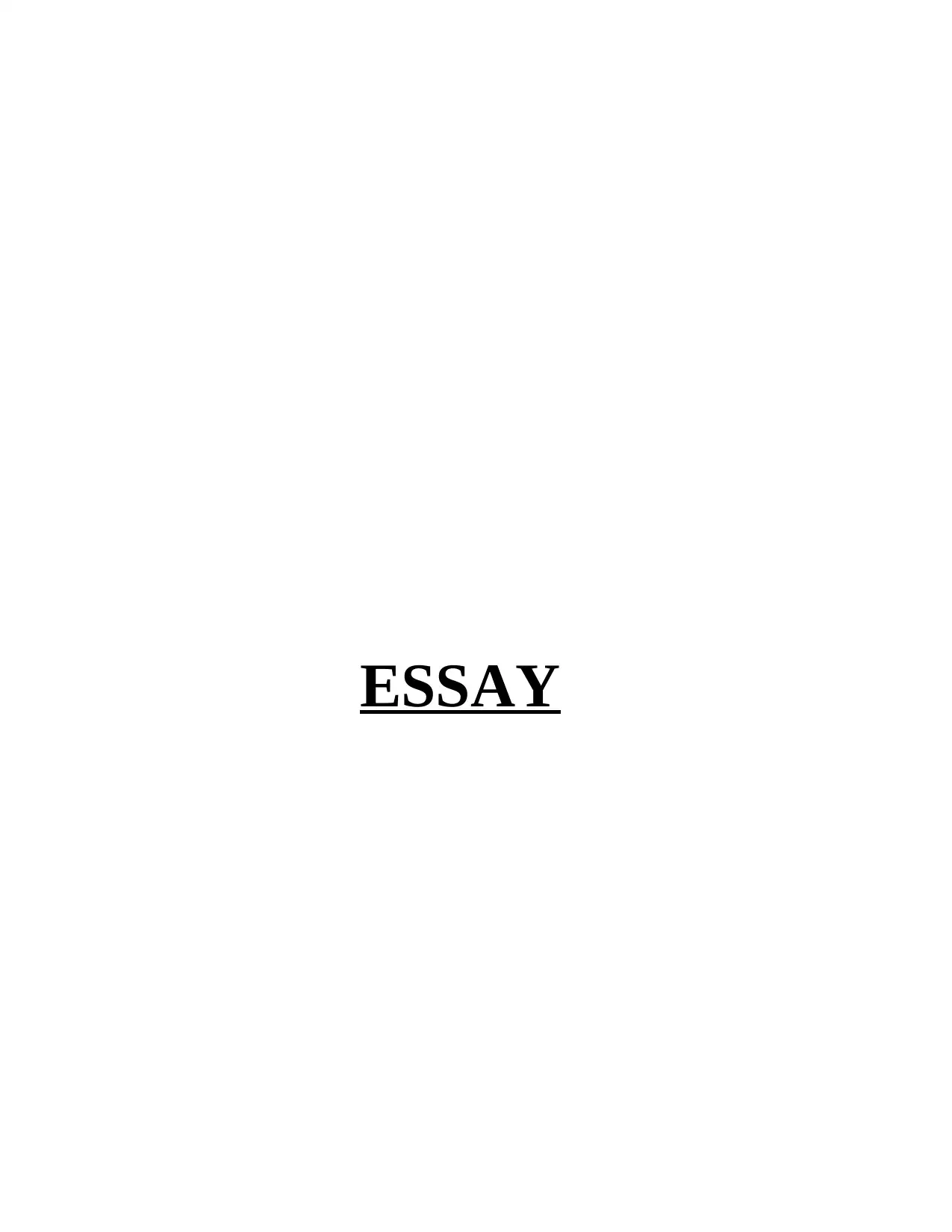
ESSAY
Paraphrase This Document
Need a fresh take? Get an instant paraphrase of this document with our AI Paraphraser
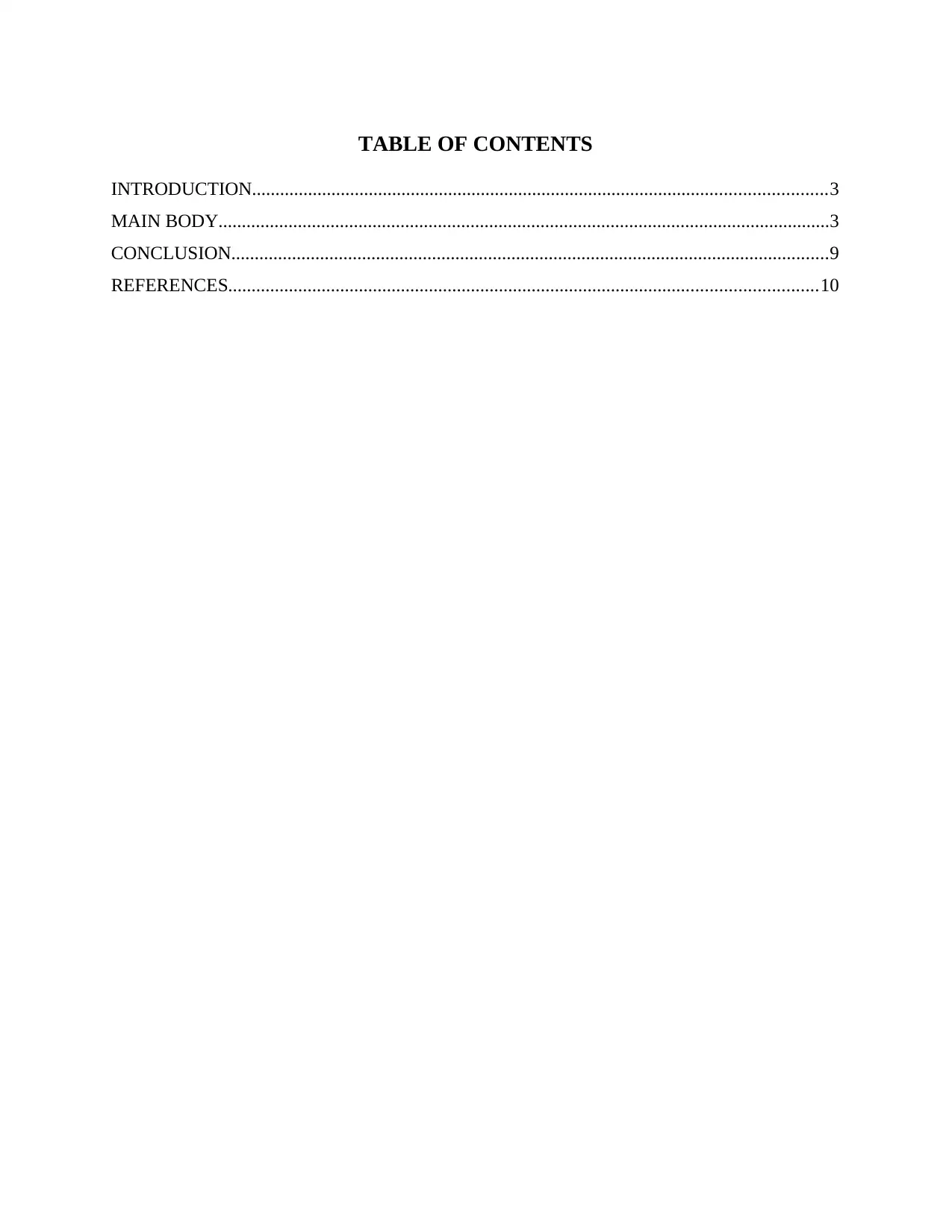
TABLE OF CONTENTS
INTRODUCTION...........................................................................................................................3
MAIN BODY...................................................................................................................................3
CONCLUSION................................................................................................................................9
REFERENCES..............................................................................................................................10
INTRODUCTION...........................................................................................................................3
MAIN BODY...................................................................................................................................3
CONCLUSION................................................................................................................................9
REFERENCES..............................................................................................................................10
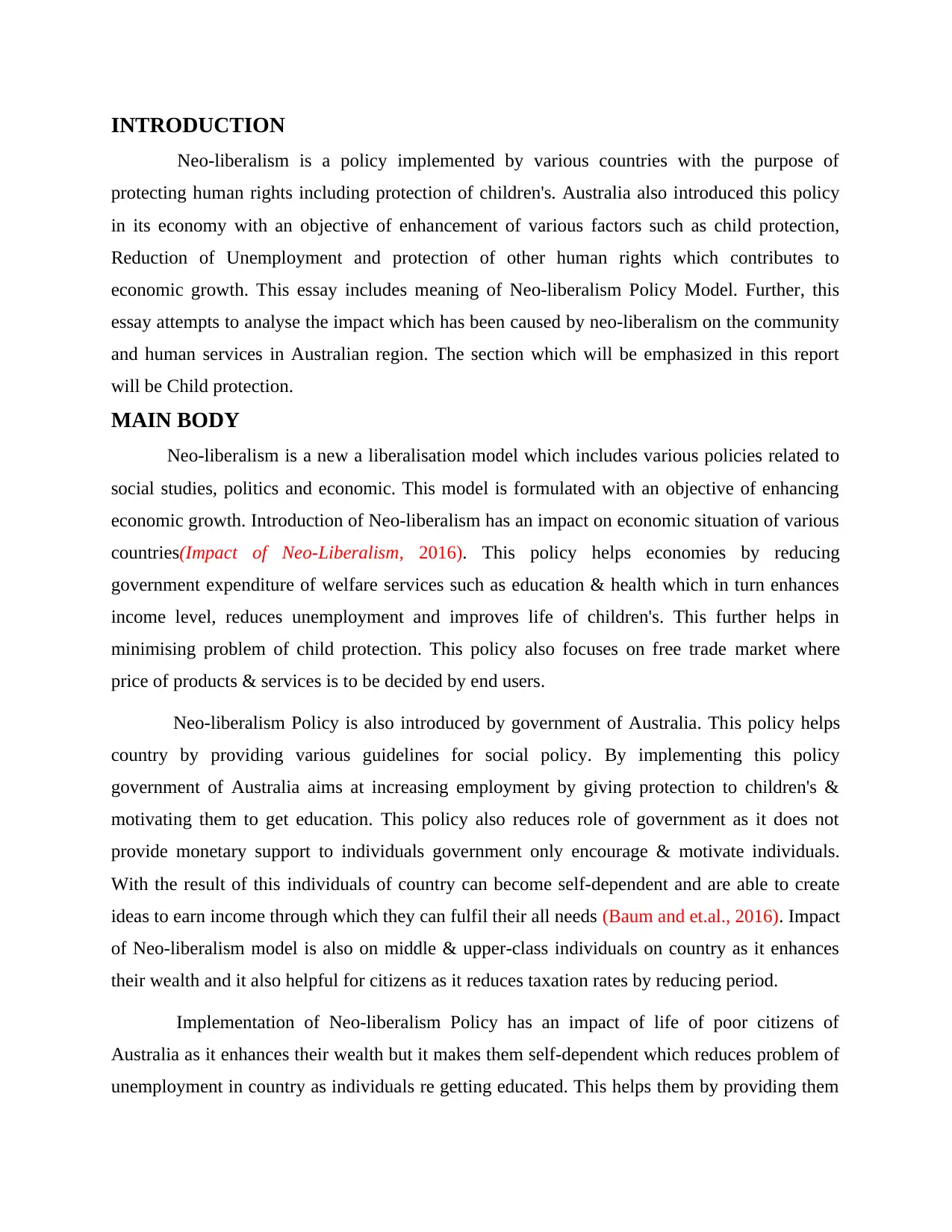
INTRODUCTION
Neo-liberalism is a policy implemented by various countries with the purpose of
protecting human rights including protection of children's. Australia also introduced this policy
in its economy with an objective of enhancement of various factors such as child protection,
Reduction of Unemployment and protection of other human rights which contributes to
economic growth. This essay includes meaning of Neo-liberalism Policy Model. Further, this
essay attempts to analyse the impact which has been caused by neo-liberalism on the community
and human services in Australian region. The section which will be emphasized in this report
will be Child protection.
MAIN BODY
Neo-liberalism is a new a liberalisation model which includes various policies related to
social studies, politics and economic. This model is formulated with an objective of enhancing
economic growth. Introduction of Neo-liberalism has an impact on economic situation of various
countries(Impact of Neo-Liberalism, 2016). This policy helps economies by reducing
government expenditure of welfare services such as education & health which in turn enhances
income level, reduces unemployment and improves life of children's. This further helps in
minimising problem of child protection. This policy also focuses on free trade market where
price of products & services is to be decided by end users.
Neo-liberalism Policy is also introduced by government of Australia. This policy helps
country by providing various guidelines for social policy. By implementing this policy
government of Australia aims at increasing employment by giving protection to children's &
motivating them to get education. This policy also reduces role of government as it does not
provide monetary support to individuals government only encourage & motivate individuals.
With the result of this individuals of country can become self-dependent and are able to create
ideas to earn income through which they can fulfil their all needs (Baum and et.al., 2016). Impact
of Neo-liberalism model is also on middle & upper-class individuals on country as it enhances
their wealth and it also helpful for citizens as it reduces taxation rates by reducing period.
Implementation of Neo-liberalism Policy has an impact of life of poor citizens of
Australia as it enhances their wealth but it makes them self-dependent which reduces problem of
unemployment in country as individuals re getting educated. This helps them by providing them
Neo-liberalism is a policy implemented by various countries with the purpose of
protecting human rights including protection of children's. Australia also introduced this policy
in its economy with an objective of enhancement of various factors such as child protection,
Reduction of Unemployment and protection of other human rights which contributes to
economic growth. This essay includes meaning of Neo-liberalism Policy Model. Further, this
essay attempts to analyse the impact which has been caused by neo-liberalism on the community
and human services in Australian region. The section which will be emphasized in this report
will be Child protection.
MAIN BODY
Neo-liberalism is a new a liberalisation model which includes various policies related to
social studies, politics and economic. This model is formulated with an objective of enhancing
economic growth. Introduction of Neo-liberalism has an impact on economic situation of various
countries(Impact of Neo-Liberalism, 2016). This policy helps economies by reducing
government expenditure of welfare services such as education & health which in turn enhances
income level, reduces unemployment and improves life of children's. This further helps in
minimising problem of child protection. This policy also focuses on free trade market where
price of products & services is to be decided by end users.
Neo-liberalism Policy is also introduced by government of Australia. This policy helps
country by providing various guidelines for social policy. By implementing this policy
government of Australia aims at increasing employment by giving protection to children's &
motivating them to get education. This policy also reduces role of government as it does not
provide monetary support to individuals government only encourage & motivate individuals.
With the result of this individuals of country can become self-dependent and are able to create
ideas to earn income through which they can fulfil their all needs (Baum and et.al., 2016). Impact
of Neo-liberalism model is also on middle & upper-class individuals on country as it enhances
their wealth and it also helpful for citizens as it reduces taxation rates by reducing period.
Implementation of Neo-liberalism Policy has an impact of life of poor citizens of
Australia as it enhances their wealth but it makes them self-dependent which reduces problem of
unemployment in country as individuals re getting educated. This helps them by providing them
⊘ This is a preview!⊘
Do you want full access?
Subscribe today to unlock all pages.

Trusted by 1+ million students worldwide
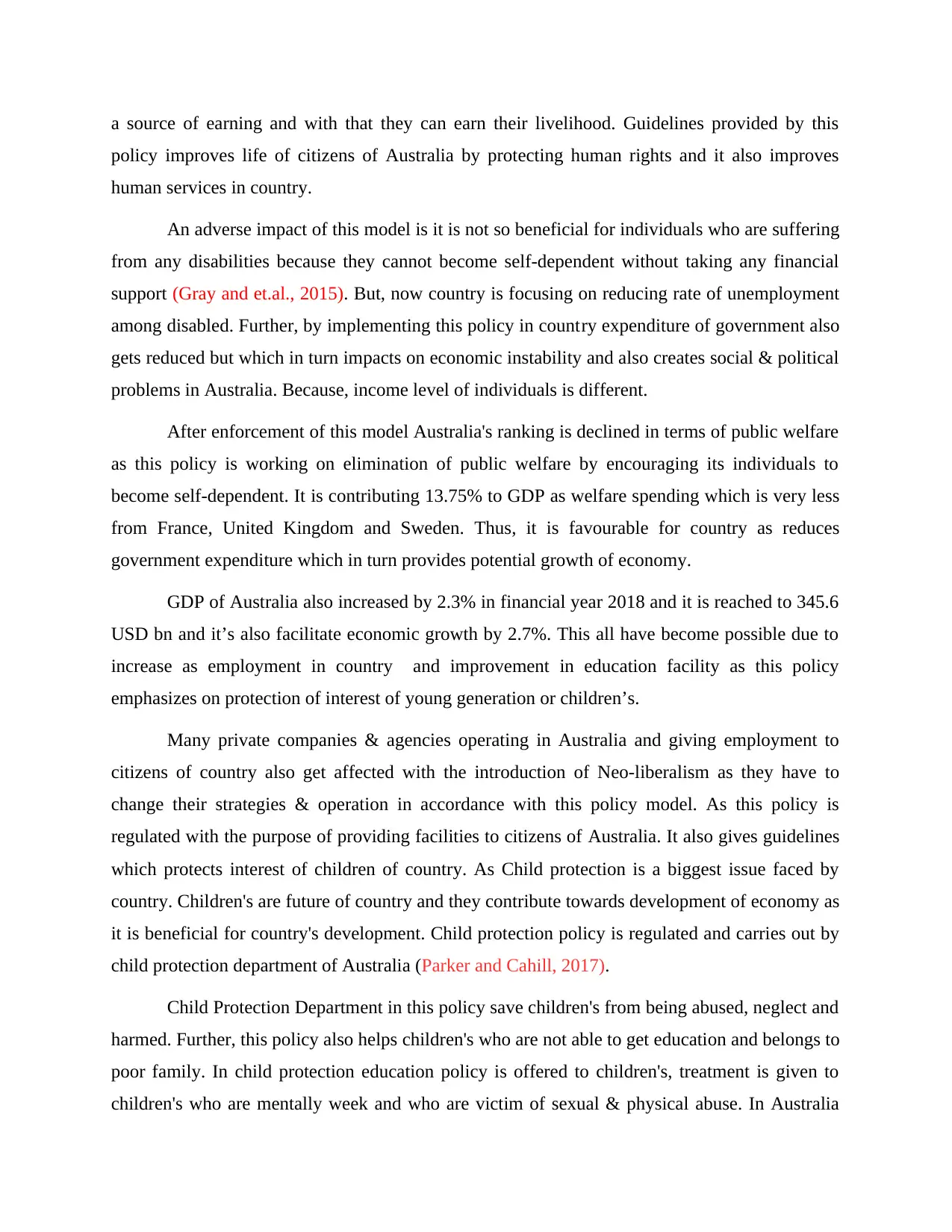
a source of earning and with that they can earn their livelihood. Guidelines provided by this
policy improves life of citizens of Australia by protecting human rights and it also improves
human services in country.
An adverse impact of this model is it is not so beneficial for individuals who are suffering
from any disabilities because they cannot become self-dependent without taking any financial
support (Gray and et.al., 2015). But, now country is focusing on reducing rate of unemployment
among disabled. Further, by implementing this policy in country expenditure of government also
gets reduced but which in turn impacts on economic instability and also creates social & political
problems in Australia. Because, income level of individuals is different.
After enforcement of this model Australia's ranking is declined in terms of public welfare
as this policy is working on elimination of public welfare by encouraging its individuals to
become self-dependent. It is contributing 13.75% to GDP as welfare spending which is very less
from France, United Kingdom and Sweden. Thus, it is favourable for country as reduces
government expenditure which in turn provides potential growth of economy.
GDP of Australia also increased by 2.3% in financial year 2018 and it is reached to 345.6
USD bn and it’s also facilitate economic growth by 2.7%. This all have become possible due to
increase as employment in country and improvement in education facility as this policy
emphasizes on protection of interest of young generation or children’s.
Many private companies & agencies operating in Australia and giving employment to
citizens of country also get affected with the introduction of Neo-liberalism as they have to
change their strategies & operation in accordance with this policy model. As this policy is
regulated with the purpose of providing facilities to citizens of Australia. It also gives guidelines
which protects interest of children of country. As Child protection is a biggest issue faced by
country. Children's are future of country and they contribute towards development of economy as
it is beneficial for country's development. Child protection policy is regulated and carries out by
child protection department of Australia (Parker and Cahill, 2017).
Child Protection Department in this policy save children's from being abused, neglect and
harmed. Further, this policy also helps children's who are not able to get education and belongs to
poor family. In child protection education policy is offered to children's, treatment is given to
children's who are mentally week and who are victim of sexual & physical abuse. In Australia
policy improves life of citizens of Australia by protecting human rights and it also improves
human services in country.
An adverse impact of this model is it is not so beneficial for individuals who are suffering
from any disabilities because they cannot become self-dependent without taking any financial
support (Gray and et.al., 2015). But, now country is focusing on reducing rate of unemployment
among disabled. Further, by implementing this policy in country expenditure of government also
gets reduced but which in turn impacts on economic instability and also creates social & political
problems in Australia. Because, income level of individuals is different.
After enforcement of this model Australia's ranking is declined in terms of public welfare
as this policy is working on elimination of public welfare by encouraging its individuals to
become self-dependent. It is contributing 13.75% to GDP as welfare spending which is very less
from France, United Kingdom and Sweden. Thus, it is favourable for country as reduces
government expenditure which in turn provides potential growth of economy.
GDP of Australia also increased by 2.3% in financial year 2018 and it is reached to 345.6
USD bn and it’s also facilitate economic growth by 2.7%. This all have become possible due to
increase as employment in country and improvement in education facility as this policy
emphasizes on protection of interest of young generation or children’s.
Many private companies & agencies operating in Australia and giving employment to
citizens of country also get affected with the introduction of Neo-liberalism as they have to
change their strategies & operation in accordance with this policy model. As this policy is
regulated with the purpose of providing facilities to citizens of Australia. It also gives guidelines
which protects interest of children of country. As Child protection is a biggest issue faced by
country. Children's are future of country and they contribute towards development of economy as
it is beneficial for country's development. Child protection policy is regulated and carries out by
child protection department of Australia (Parker and Cahill, 2017).
Child Protection Department in this policy save children's from being abused, neglect and
harmed. Further, this policy also helps children's who are not able to get education and belongs to
poor family. In child protection education policy is offered to children's, treatment is given to
children's who are mentally week and who are victim of sexual & physical abuse. In Australia
Paraphrase This Document
Need a fresh take? Get an instant paraphrase of this document with our AI Paraphraser

child harassment and sexual abuse is increasing day by day and this creates a negative impact on
countries economy thus, with child protection number of child workers are also reduced.
Reduction in such unethical aspects improves economic situation of Australia. This possible by
giving education and giving them emotional support (Smyth, 2016 and Louise, 2014).
In Australia child protection aims at protection of child by imposing restriction on private
companies as not to give employment to children below the age of 14 year's. If any organisation
is employing children at their work place than there are chances of cancellation of license
according to guidelines provided by this policy. Child Protection also helps in providing safe
environment to children's and members of department of child protection also observe behaviour
of children's and treat them accordingly. This helps in reducing number of Australian children
who are under protection and are victim of mental & physical molestation.
Introduction of Neo-liberalism policy is very beneficial for Australia as according to a
statistical research, child abuse and lack of education in children in country is increasing day by
day. All these problems can be resolved with Child protection policy introduced by government
of Australia. This policy gives guidelines to companies & organisations so that they can provide
safe & health atmosphere to children (Churchill and Fawcett, 2016). As per results received from
a study it is found that one child among 35 children's in Australia is under Child Protection.
Thus, it is a serious issue to handle and it also impacts on economic condition of country.
3,96,000 children of Australia including indigenous & aboriginal are suffering from child
employment, 89,000 children are victim of physical abuse and out of these 1,59,000 children are
under Child protection, this all becomes possible with execution of Neo-liberalism Policy Model.
These children's who are under Child Protection are victims of emotional abuse, neglect, physical
& sexual abuse.
It is very important for Australia to eliminate & reduce number of children's who are
under Child Protection as it increases number of child employees, sexual and physical abuse in
children's which in turn creates situation of unemployment in adults, reduces literacy rate with in
country and reduces net wages of country as more of employment is given to children at zero
wages. Thus, Child Protection under Neo-liberalism policy has an impact of children
employment as it focuses on creating dependency among its citizens and it also motivates them
to get employment. If employment in adults gets increases than that apparently reduces problem
countries economy thus, with child protection number of child workers are also reduced.
Reduction in such unethical aspects improves economic situation of Australia. This possible by
giving education and giving them emotional support (Smyth, 2016 and Louise, 2014).
In Australia child protection aims at protection of child by imposing restriction on private
companies as not to give employment to children below the age of 14 year's. If any organisation
is employing children at their work place than there are chances of cancellation of license
according to guidelines provided by this policy. Child Protection also helps in providing safe
environment to children's and members of department of child protection also observe behaviour
of children's and treat them accordingly. This helps in reducing number of Australian children
who are under protection and are victim of mental & physical molestation.
Introduction of Neo-liberalism policy is very beneficial for Australia as according to a
statistical research, child abuse and lack of education in children in country is increasing day by
day. All these problems can be resolved with Child protection policy introduced by government
of Australia. This policy gives guidelines to companies & organisations so that they can provide
safe & health atmosphere to children (Churchill and Fawcett, 2016). As per results received from
a study it is found that one child among 35 children's in Australia is under Child Protection.
Thus, it is a serious issue to handle and it also impacts on economic condition of country.
3,96,000 children of Australia including indigenous & aboriginal are suffering from child
employment, 89,000 children are victim of physical abuse and out of these 1,59,000 children are
under Child protection, this all becomes possible with execution of Neo-liberalism Policy Model.
These children's who are under Child Protection are victims of emotional abuse, neglect, physical
& sexual abuse.
It is very important for Australia to eliminate & reduce number of children's who are
under Child Protection as it increases number of child employees, sexual and physical abuse in
children's which in turn creates situation of unemployment in adults, reduces literacy rate with in
country and reduces net wages of country as more of employment is given to children at zero
wages. Thus, Child Protection under Neo-liberalism policy has an impact of children
employment as it focuses on creating dependency among its citizens and it also motivates them
to get employment. If employment in adults gets increases than that apparently reduces problem

of children employment which in turn resolves number of children's who are under Child
protection. Child Protection also influences families of country to educate their children's by
becoming self-dependent and earning income by doing work so that this problem can be
eliminated.
Development of Neo-liberalism in Australia give rise to protection of children's who are
suffering from various problems. By protection of child & child employees number child
workers have decreased and which in turn enhances wage pay of economy that strengthen
economic condition (Beer, 2016). This also improves life style & knowledge of individuals so
that country does not need to organise policy for protection of children's. Emphasis of this policy
is on improvement in children's condition which also enhances rate of employment in 2018 as
adults are becoming self-operated and they are establishing new business. Unemployment rate in
Australia drop down to 5.4% in last 4 years with the protection given to children's because
children are going to schools and they are not working thus, companies are now employing
adults.
With the emergence of Child Protection child employees, and child neglect in country is
declined and in 2018 it is reduced by one third as compared to last four years. Improvement of
Child protection number of paid employment get increased and more numbers of children are
getting education. Thus, they use technology at their work place which in turn helps country in
maximising use of digital technology (Featherstone and et.al., 2018). Use of digital technology
also beneficial for companies as their operation process gets faster which leads to increase in
profits, market share & customer base of organisation. All child protection services further
contribute in economic development of Australia.
Further, various acts are also formulated by government of Australia such as Adoption
Act, 2000 and Child Protection Act, 2002. According to provisions of these acts following
guidelines has to followed by Child Protection Department of all regions of Australia to
minimise Child Protection, which are discussed below-
Protection of Children's Interest- For reducing this problem Members of department of
Child Protection 1st need to identify interest of children's and problems they are suffering from
this further helps members in making decisions to solve problems of children's.
protection. Child Protection also influences families of country to educate their children's by
becoming self-dependent and earning income by doing work so that this problem can be
eliminated.
Development of Neo-liberalism in Australia give rise to protection of children's who are
suffering from various problems. By protection of child & child employees number child
workers have decreased and which in turn enhances wage pay of economy that strengthen
economic condition (Beer, 2016). This also improves life style & knowledge of individuals so
that country does not need to organise policy for protection of children's. Emphasis of this policy
is on improvement in children's condition which also enhances rate of employment in 2018 as
adults are becoming self-operated and they are establishing new business. Unemployment rate in
Australia drop down to 5.4% in last 4 years with the protection given to children's because
children are going to schools and they are not working thus, companies are now employing
adults.
With the emergence of Child Protection child employees, and child neglect in country is
declined and in 2018 it is reduced by one third as compared to last four years. Improvement of
Child protection number of paid employment get increased and more numbers of children are
getting education. Thus, they use technology at their work place which in turn helps country in
maximising use of digital technology (Featherstone and et.al., 2018). Use of digital technology
also beneficial for companies as their operation process gets faster which leads to increase in
profits, market share & customer base of organisation. All child protection services further
contribute in economic development of Australia.
Further, various acts are also formulated by government of Australia such as Adoption
Act, 2000 and Child Protection Act, 2002. According to provisions of these acts following
guidelines has to followed by Child Protection Department of all regions of Australia to
minimise Child Protection, which are discussed below-
Protection of Children's Interest- For reducing this problem Members of department of
Child Protection 1st need to identify interest of children's and problems they are suffering from
this further helps members in making decisions to solve problems of children's.
⊘ This is a preview!⊘
Do you want full access?
Subscribe today to unlock all pages.

Trusted by 1+ million students worldwide
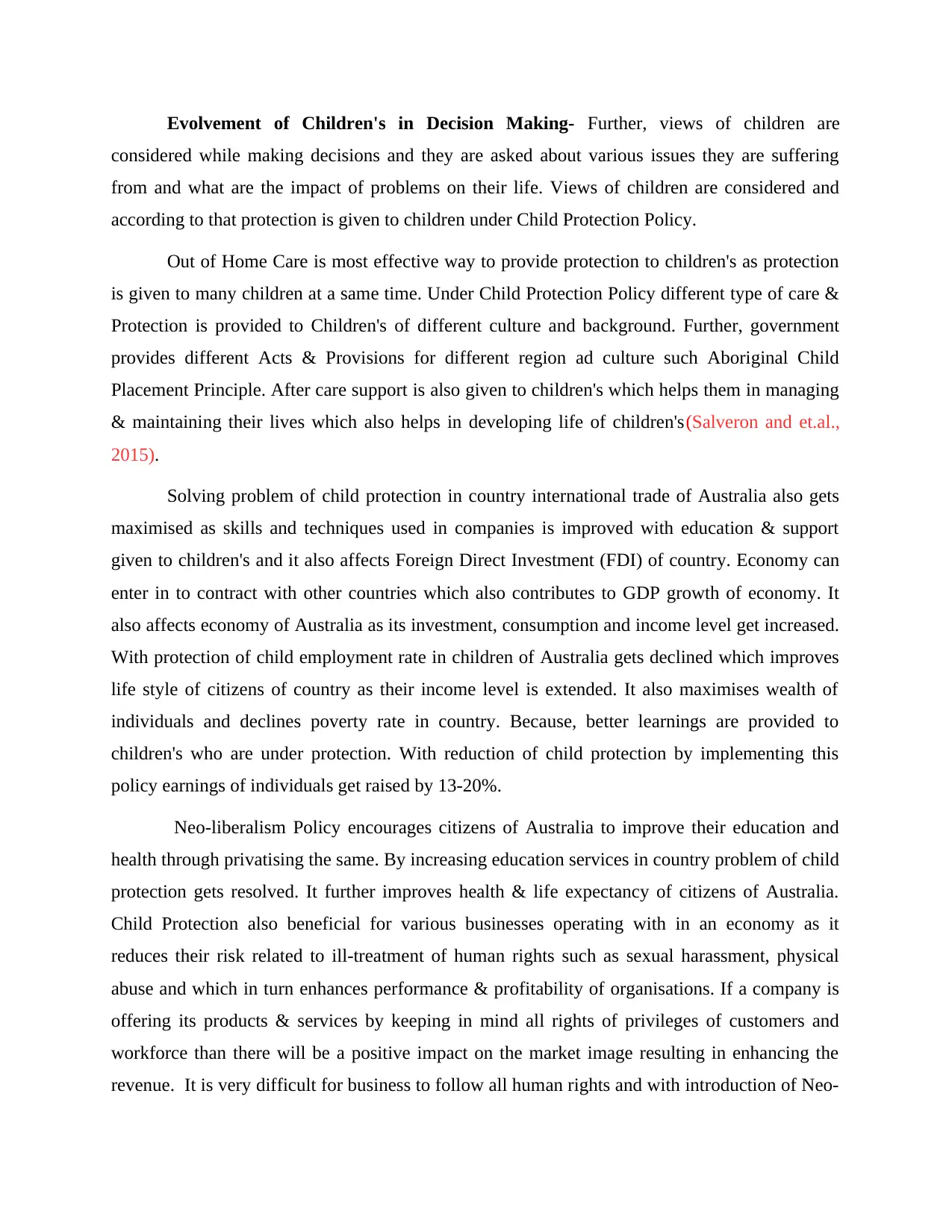
Evolvement of Children's in Decision Making- Further, views of children are
considered while making decisions and they are asked about various issues they are suffering
from and what are the impact of problems on their life. Views of children are considered and
according to that protection is given to children under Child Protection Policy.
Out of Home Care is most effective way to provide protection to children's as protection
is given to many children at a same time. Under Child Protection Policy different type of care &
Protection is provided to Children's of different culture and background. Further, government
provides different Acts & Provisions for different region ad culture such Aboriginal Child
Placement Principle. After care support is also given to children's which helps them in managing
& maintaining their lives which also helps in developing life of children's(Salveron and et.al.,
2015).
Solving problem of child protection in country international trade of Australia also gets
maximised as skills and techniques used in companies is improved with education & support
given to children's and it also affects Foreign Direct Investment (FDI) of country. Economy can
enter in to contract with other countries which also contributes to GDP growth of economy. It
also affects economy of Australia as its investment, consumption and income level get increased.
With protection of child employment rate in children of Australia gets declined which improves
life style of citizens of country as their income level is extended. It also maximises wealth of
individuals and declines poverty rate in country. Because, better learnings are provided to
children's who are under protection. With reduction of child protection by implementing this
policy earnings of individuals get raised by 13-20%.
Neo-liberalism Policy encourages citizens of Australia to improve their education and
health through privatising the same. By increasing education services in country problem of child
protection gets resolved. It further improves health & life expectancy of citizens of Australia.
Child Protection also beneficial for various businesses operating with in an economy as it
reduces their risk related to ill-treatment of human rights such as sexual harassment, physical
abuse and which in turn enhances performance & profitability of organisations. If a company is
offering its products & services by keeping in mind all rights of privileges of customers and
workforce than there will be a positive impact on the market image resulting in enhancing the
revenue. It is very difficult for business to follow all human rights and with introduction of Neo-
considered while making decisions and they are asked about various issues they are suffering
from and what are the impact of problems on their life. Views of children are considered and
according to that protection is given to children under Child Protection Policy.
Out of Home Care is most effective way to provide protection to children's as protection
is given to many children at a same time. Under Child Protection Policy different type of care &
Protection is provided to Children's of different culture and background. Further, government
provides different Acts & Provisions for different region ad culture such Aboriginal Child
Placement Principle. After care support is also given to children's which helps them in managing
& maintaining their lives which also helps in developing life of children's(Salveron and et.al.,
2015).
Solving problem of child protection in country international trade of Australia also gets
maximised as skills and techniques used in companies is improved with education & support
given to children's and it also affects Foreign Direct Investment (FDI) of country. Economy can
enter in to contract with other countries which also contributes to GDP growth of economy. It
also affects economy of Australia as its investment, consumption and income level get increased.
With protection of child employment rate in children of Australia gets declined which improves
life style of citizens of country as their income level is extended. It also maximises wealth of
individuals and declines poverty rate in country. Because, better learnings are provided to
children's who are under protection. With reduction of child protection by implementing this
policy earnings of individuals get raised by 13-20%.
Neo-liberalism Policy encourages citizens of Australia to improve their education and
health through privatising the same. By increasing education services in country problem of child
protection gets resolved. It further improves health & life expectancy of citizens of Australia.
Child Protection also beneficial for various businesses operating with in an economy as it
reduces their risk related to ill-treatment of human rights such as sexual harassment, physical
abuse and which in turn enhances performance & profitability of organisations. If a company is
offering its products & services by keeping in mind all rights of privileges of customers and
workforce than there will be a positive impact on the market image resulting in enhancing the
revenue. It is very difficult for business to follow all human rights and with introduction of Neo-
Paraphrase This Document
Need a fresh take? Get an instant paraphrase of this document with our AI Paraphraser
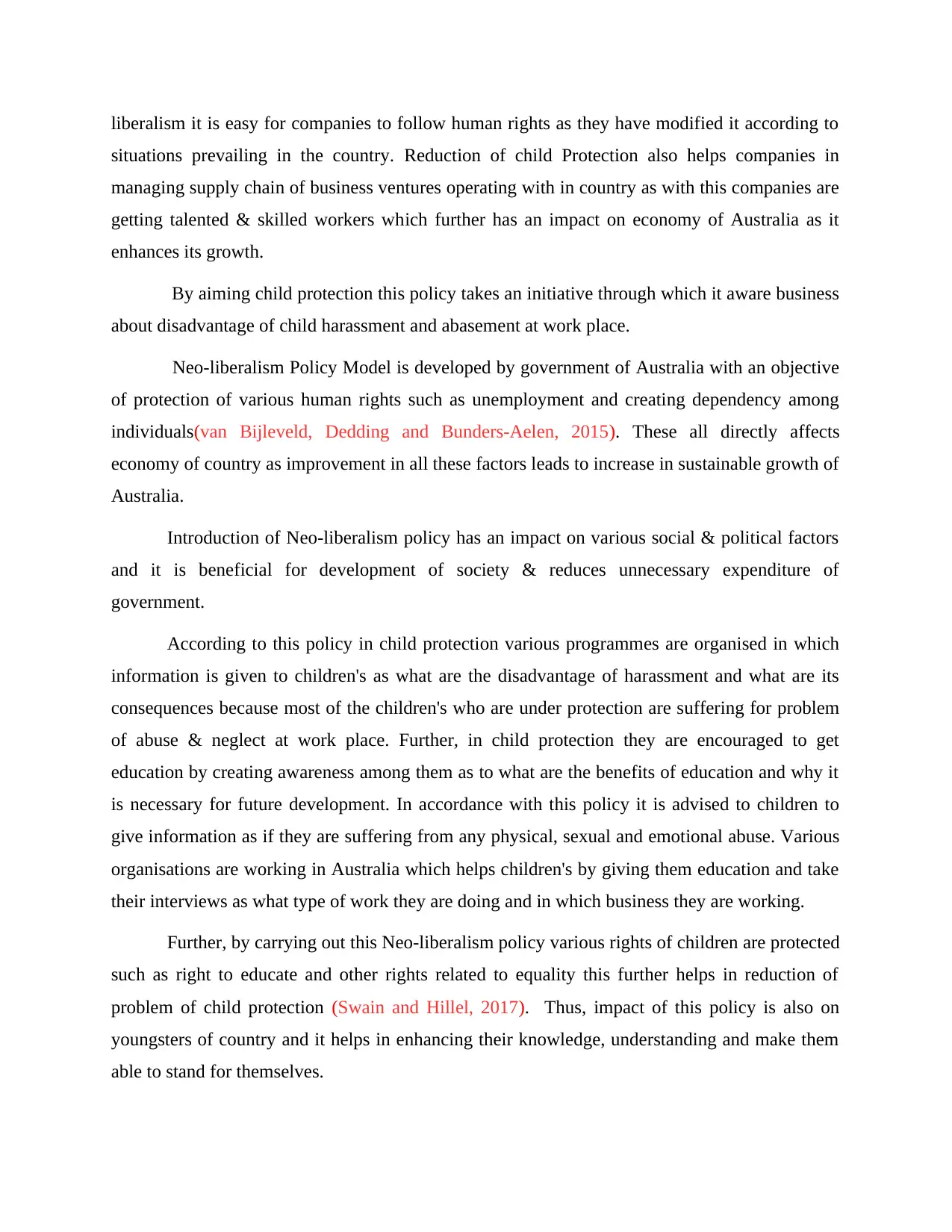
liberalism it is easy for companies to follow human rights as they have modified it according to
situations prevailing in the country. Reduction of child Protection also helps companies in
managing supply chain of business ventures operating with in country as with this companies are
getting talented & skilled workers which further has an impact on economy of Australia as it
enhances its growth.
By aiming child protection this policy takes an initiative through which it aware business
about disadvantage of child harassment and abasement at work place.
Neo-liberalism Policy Model is developed by government of Australia with an objective
of protection of various human rights such as unemployment and creating dependency among
individuals(van Bijleveld, Dedding and Bunders‐Aelen, 2015). These all directly affects
economy of country as improvement in all these factors leads to increase in sustainable growth of
Australia.
Introduction of Neo-liberalism policy has an impact on various social & political factors
and it is beneficial for development of society & reduces unnecessary expenditure of
government.
According to this policy in child protection various programmes are organised in which
information is given to children's as what are the disadvantage of harassment and what are its
consequences because most of the children's who are under protection are suffering for problem
of abuse & neglect at work place. Further, in child protection they are encouraged to get
education by creating awareness among them as to what are the benefits of education and why it
is necessary for future development. In accordance with this policy it is advised to children to
give information as if they are suffering from any physical, sexual and emotional abuse. Various
organisations are working in Australia which helps children's by giving them education and take
their interviews as what type of work they are doing and in which business they are working.
Further, by carrying out this Neo-liberalism policy various rights of children are protected
such as right to educate and other rights related to equality this further helps in reduction of
problem of child protection (Swain and Hillel, 2017). Thus, impact of this policy is also on
youngsters of country and it helps in enhancing their knowledge, understanding and make them
able to stand for themselves.
situations prevailing in the country. Reduction of child Protection also helps companies in
managing supply chain of business ventures operating with in country as with this companies are
getting talented & skilled workers which further has an impact on economy of Australia as it
enhances its growth.
By aiming child protection this policy takes an initiative through which it aware business
about disadvantage of child harassment and abasement at work place.
Neo-liberalism Policy Model is developed by government of Australia with an objective
of protection of various human rights such as unemployment and creating dependency among
individuals(van Bijleveld, Dedding and Bunders‐Aelen, 2015). These all directly affects
economy of country as improvement in all these factors leads to increase in sustainable growth of
Australia.
Introduction of Neo-liberalism policy has an impact on various social & political factors
and it is beneficial for development of society & reduces unnecessary expenditure of
government.
According to this policy in child protection various programmes are organised in which
information is given to children's as what are the disadvantage of harassment and what are its
consequences because most of the children's who are under protection are suffering for problem
of abuse & neglect at work place. Further, in child protection they are encouraged to get
education by creating awareness among them as to what are the benefits of education and why it
is necessary for future development. In accordance with this policy it is advised to children to
give information as if they are suffering from any physical, sexual and emotional abuse. Various
organisations are working in Australia which helps children's by giving them education and take
their interviews as what type of work they are doing and in which business they are working.
Further, by carrying out this Neo-liberalism policy various rights of children are protected
such as right to educate and other rights related to equality this further helps in reduction of
problem of child protection (Swain and Hillel, 2017). Thus, impact of this policy is also on
youngsters of country and it helps in enhancing their knowledge, understanding and make them
able to stand for themselves.
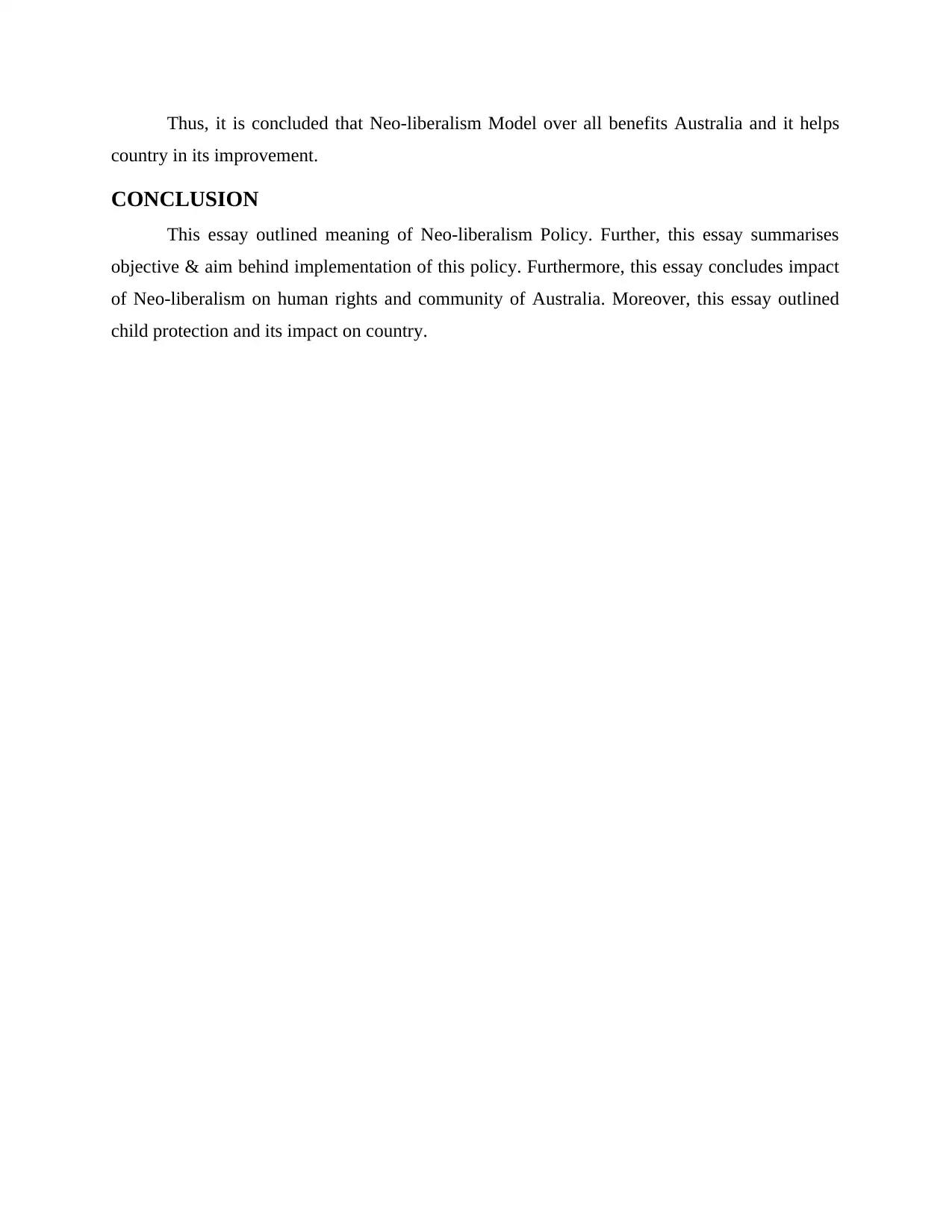
Thus, it is concluded that Neo-liberalism Model over all benefits Australia and it helps
country in its improvement.
CONCLUSION
This essay outlined meaning of Neo-liberalism Policy. Further, this essay summarises
objective & aim behind implementation of this policy. Furthermore, this essay concludes impact
of Neo-liberalism on human rights and community of Australia. Moreover, this essay outlined
child protection and its impact on country.
country in its improvement.
CONCLUSION
This essay outlined meaning of Neo-liberalism Policy. Further, this essay summarises
objective & aim behind implementation of this policy. Furthermore, this essay concludes impact
of Neo-liberalism on human rights and community of Australia. Moreover, this essay outlined
child protection and its impact on country.
⊘ This is a preview!⊘
Do you want full access?
Subscribe today to unlock all pages.

Trusted by 1+ million students worldwide

REFERENCES
Books and Journal
Baum, F. & et. al, (2016). Comprehensive primary health care under neo-liberalism in Australia.
Social Science & Medicine, 168, 43-52.
Churchill, H., & Fawcett, B. (2016). Refocusing on early intervention and family support: A
review of child welfare reforms in New South Wales, Australia. Social Policy and
Society, 15(2), 303-316.
Gray, M. & et. al, (2015). Perspectives on neo-liberalism for human service professionals. Social
Service Review, 89 (2), 368-392.
Beer, A. (2016). The economic geography of Australia and its analysis: From industrial to post‐
industrial regions. Geographical Research, 50(3), 269-281.
Swain, S., & Hillel, M. (2017). Child, nation, race and empire: Child rescue discourse, England,
Canada and Australia, 1850–1915.
Salveron, M. & et.al., (2015). ‘Changing the way we do child protection’: The implementation of
Signs of Safety® within the Western Australia Department for Child Protection and
Family Support. Children and youth services review. 48. 126-139.
van Bijleveld, G. G., Dedding, C. W., & Bunders‐Aelen, J. F. (2015). Children's and young
people's participation within child welfare and child protection services: a state‐of‐the‐art
review. Child & Family Social Work. 20(2). 129-138.
Featherstone, B. & et.al., (2018). Let's stop feeding the risk monster: towards a social model
of'child protection'. Families, Relationships and Societies. 7(1). 7-22.
Smyth, P. (2016). Louise Humpage (2014), Policy Change, Public Attitudes and Social
Citizenship: Does Neoliberalism Matter? Bristol: Policy Press.£ 75.00, pp. 272,
hbk. Journal of Social Policy. 45(4). 776-777.
Parker, J., & Cahill, D. (2017). The retreat from neoliberalism that was not: Australia’s Building
the Education Revolution. Australian Journal of Political Science. 52(2). 257-271.
Online
Impact of Neo-Liberalism, 2016. [Online]. Available through: <https://theconversation.com/the-
state-of-australia-welfare-and-inequality-26037>
Books and Journal
Baum, F. & et. al, (2016). Comprehensive primary health care under neo-liberalism in Australia.
Social Science & Medicine, 168, 43-52.
Churchill, H., & Fawcett, B. (2016). Refocusing on early intervention and family support: A
review of child welfare reforms in New South Wales, Australia. Social Policy and
Society, 15(2), 303-316.
Gray, M. & et. al, (2015). Perspectives on neo-liberalism for human service professionals. Social
Service Review, 89 (2), 368-392.
Beer, A. (2016). The economic geography of Australia and its analysis: From industrial to post‐
industrial regions. Geographical Research, 50(3), 269-281.
Swain, S., & Hillel, M. (2017). Child, nation, race and empire: Child rescue discourse, England,
Canada and Australia, 1850–1915.
Salveron, M. & et.al., (2015). ‘Changing the way we do child protection’: The implementation of
Signs of Safety® within the Western Australia Department for Child Protection and
Family Support. Children and youth services review. 48. 126-139.
van Bijleveld, G. G., Dedding, C. W., & Bunders‐Aelen, J. F. (2015). Children's and young
people's participation within child welfare and child protection services: a state‐of‐the‐art
review. Child & Family Social Work. 20(2). 129-138.
Featherstone, B. & et.al., (2018). Let's stop feeding the risk monster: towards a social model
of'child protection'. Families, Relationships and Societies. 7(1). 7-22.
Smyth, P. (2016). Louise Humpage (2014), Policy Change, Public Attitudes and Social
Citizenship: Does Neoliberalism Matter? Bristol: Policy Press.£ 75.00, pp. 272,
hbk. Journal of Social Policy. 45(4). 776-777.
Parker, J., & Cahill, D. (2017). The retreat from neoliberalism that was not: Australia’s Building
the Education Revolution. Australian Journal of Political Science. 52(2). 257-271.
Online
Impact of Neo-Liberalism, 2016. [Online]. Available through: <https://theconversation.com/the-
state-of-australia-welfare-and-inequality-26037>
1 out of 10
Related Documents
Your All-in-One AI-Powered Toolkit for Academic Success.
+13062052269
info@desklib.com
Available 24*7 on WhatsApp / Email
![[object Object]](/_next/static/media/star-bottom.7253800d.svg)
Unlock your academic potential
Copyright © 2020–2025 A2Z Services. All Rights Reserved. Developed and managed by ZUCOL.




